All about irrigators

In the fast paced pace of life, we sometimes forget about the need for careful oral care. Ohowever, brushing twice a day is sometimes not enough. That is why dentists all over the world recommend using an irrigator - a water cleaner for the oral cavity, it effectively removes plaque, flushes out all impurities from the interdental space and easily massages the gums.


What it is?
The food particles that get stuck in the gaps between your teeth are very few people will like. In addition, they quickly begin to rot - this leads to the appearance of an unpleasant odor and causes dental diseases. The easiest way is to take a toothpick and walk through the interdental space. However, the use of sharp objects will injure the surrounding teeth and tissues. Getting into the cavities between the teeth, the toothpick acts as a lever and loosens them.
Flossing will be more effective. However, sometimes it is very inconvenient to use it, so dentists recommend purchasing an irrigator. This device is a complete and at the same time completely safe alternative to traditional toothpicks. The device guarantees the prevention of dental diseases, reduces the risk of caries and other damage to the oral cavity.


Irrigators are especially necessary for people with implants.
This is due to the fact that the crowns are not tightly adjacent to the teeth. There are cavities under them, pieces of food get stuck in them, you cannot reach them with a toothpick. Over time, the food begins to rot - this leads to bad breath, the development of inflammatory processes in the gums and even the rejection of the implant.

An irrigator is a hygienic device that allows you to effectively clean the oral cavity even where a toothbrush cannot reach. The principle of operation is based on a powerful water jet, which, under pressure, efficiently and rather quickly flushes food residues from the inner surfaces of the teeth, from the periodontal pocket and interdental space.
The indications for the operation of the irrigator are:
- preventive measures to prevent caries, periodontitis and other pathologies of the oral cavity;
- reduction of soft tissue bleeding;
- cleaning teeth in hard-to-reach areas;
- elimination of pungent odor from the mouth.


Benefit and harm
The benefits of using an irrigator are due to its undoubted advantages:
- the package usually includes several attachments that allow you to clean not only the teeth, but also the tongue, gums and braces;
- the irrigator has the effect of light massage of the gums - it normalizes blood circulation in soft tissues;
- the device operates in several modes of solution supply, so each user can choose a fluid pressure level that is comfortable for himself, taking into account physiological characteristics.
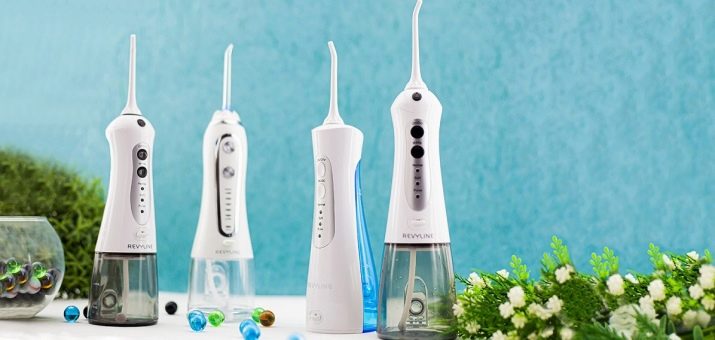
Although there were some drawbacks:
- lack of functioning in spray mode;
- nozzles do not rotate 360 degrees;
- lack of the possibility of automatic shutdown.


There are situations in which the use of an irrigator is not recommended:
- recent oral surgery;
- incomplete treatment of caries and other pathologies of the gums and teeth;
- acute periodontitis;
- when the gums have been bleeding for two or more weeks.
The influence of the device can be harmful for certain heart diseases; any tumor processes are also a contraindication to the use of the device.
That is why it is imperative to get the advice of a dentist before using the irrigator.
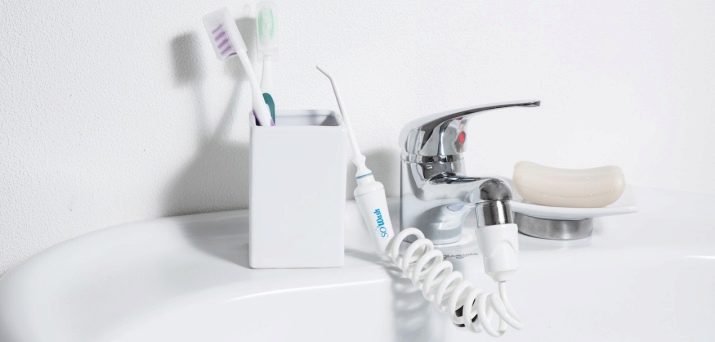
Views
Today manufacturers offer a wide range of different models of irrigators for the home. They can be manual, mechanical, ultrasonic and pulsed. A group of professional devices is distinguished. They can be conditionally divided into three categories.
Portable
The most convenient ones are mobile devices. They are not as bulky as stationary irrigators. They run on batteries, so you can take them on trips and hikes. They are characterized by low pressure, therefore they can be used for sensitive teeth, including children.
It is these devices that will be the best choice for babies.



Stationary
The stationary versions are AC powered and are classic household products. Water or a healing solution in them comes to the nozzle through the handle - this is quite convenient, because in this case, the jet is immediately supplied to the treated area of the oral cavity.


Flowing
Plumbing irrigators are equipped with special adapters through which they can be connected to the water supply tap. They are easy-to-use devices, they do not require special efforts and special skills from their owners. However, ordinary tap water is used here to clean teeth and gums, and it does not always meet sanitary standards.


Types of food
By the type of power supply, irrigators can be mains powered and battery operated.
Network
As a rule, these are large devices with a wide range of functions. They are installed in the bathroom and are powered from the electrical network. If desired, such a device can be carried with you (when traveling), but this is not entirely rational.
As for the impact, the stationary apparatus is more powerful than the portable one. Therefore, teeth cleaning also produces better quality. These devices can be used by the whole family.


Battery powered
The battery operated irrigator is powered by a rechargeable battery and needs to be recharged from time to time. Usually it is enough to charge it for operation for three to five days. Such models are lightweight and have compact dimensions, which makes them possible to use on the road. However, the water supply is carried out under reduced pressure, therefore, the device is slightly inferior to the mains one in terms of the quality of teeth cleaning.

How to choose?
When choosing an irrigator model, you should pay attention to its main functional characteristics.
- Jet. Different models of irrigators can produce a pulsating continuous stream or create a bath of air bubbles. The latter option is preferable for younger users. Such treatment has a pronounced bactericidal effect and removes all plaque from the teeth as efficiently as possible.

- Dimensions. If you often travel and go to the country house, where there are power outages, it is better to give preference to compact portable devices powered by batteries or accumulators. For home use, stationary devices with a wide range of useful functions and several high-speed operating modes are more preferable.


- Replaceable nozzles. If all households use the irrigator, each of them will need their own individual nozzle. It is desirable that they be of different colors - so you will never confuse them. There are five types of attachments.
- Standard - Used to clean healthy soft and hard tissue.
- Orthodontic - suitable for removing plaque under the gingival margin, as well as under braces.
- Periodontal - a special nozzle with a rubber tip. It directs a stream of healing fluid into the periodontal pocket and effectively cleans soft tissues.
- Stone Removal Tip - Provides an exceptional effect on crowns, implants and bridges.
- Tongue cleaning attachment - quickly and effectively removes all plaque from the cheeks and tongue, thereby neutralizing the cause of an unpleasant putrid odor.

The standard irrigator head should be changed every six months. Periodontal and orthodontic tips must be replaced every quarter.
And of course, you need to focus on ease of use. The irrigator should be ergonomic, lightweight and manoeuvrable. It is desirable that he has a device for mounting on a wall and a cover.



Popular models
Let's take a closer look at the best-selling models. The most in demand are German, North American copies, as well as devices from manufacturers from the Netherlands and Korea.
SoWash "Family"
A modern universal irrigator that allows you to quickly and in a short time effectively clean the hard and soft tissues of the oral cavity from food residues and other contaminants. The device copes well with even the most chronic plaque. During the treatment, the gums are massaged in parallel, thereby normalizing metabolism and accelerating blood circulation.
The kit includes one- and three-jet nozzles. This allows you to set the flow parameters for young and adult users. Such an irrigator is suitable for use by all family members.
Doctors recommend it to patients with crowns, implants and braces.

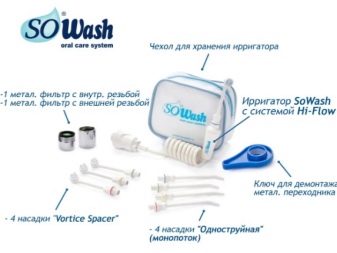
Waterpik Aquarius Water Flosser
A powerful family stationary irrigator from the universal category. Differs in ease of use, has 10 modes of water flow: from the position of the child to the level of processing dentures. There is a 2 in 1 mode: dental floss and hydromassage. The first works by analogy with floss, cleans out hard-to-reach areas and flushes out all product residues. The second one carries out light hydromassage of soft tissues, due to which the prevention of bleeding and inflammation of the gums.


Philips HX8331
A reliable model of a mobile irrigator with three operating speeds. Suitable for everyday dental tissue processing. Powered by micro-bubble technology, the device is optimal for users with sensitive teeth and children. The nozzle easily penetrates into any interdental spaces, cleans the gums and tongue. The device is made of light plastic, equipped with indicators for battery charging and operation, a charger is included in the package.


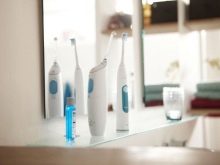
Electronic AR-W-11
Another portable model for cleaning hard-to-reach areas. Effectively cleans out stuck food particles and pathogenic microflora. Removes plaque, eliminates bad breath and cares for the gums. Includes one standard replacement nozzle and 60 ml fluid reservoir.
This gargle comes in black. It does not have additional functions, but it copes with its main task perfectly. The irrigator can be operated both from batteries and from the mains. Due to its small size, it easily fits in your luggage, so you can take such a device with you outdoors or on a trip.

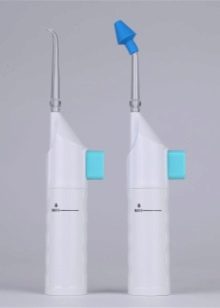

The Dental SPA flushing device (USA) is very popular., dentists advise users to pay attention to the Braun Oral-B (Germany) model.


How to use it correctly?
The instructions for the irrigator indicate the permissible solutions that can be purchased for cleaning, as well as those that should never be poured into them.
In 90% of cases, the irrigator is filled with the simplest tap water, heated to 30-40 degrees. Brushing your teeth too cold or hot will be uncomfortable.
If the quality of the liquid does not suit you, you can pre-filter it or boil it.
Specialized rinses are also acceptable. Please note that they should be specifically for irrigators. They are used as part of a therapeutic course as prescribed by a doctor and are not used on an ongoing basis.


Now let's list what is strictly forbidden to use.
- Any liquid containing small particles. It can be saline, soda solutions, suspensions and decoctions. Even when well filtered, they still have suspensions that will remain on the inner surfaces of the device. As a result, the gaps are clogged - the pump has to make more effort to pump the liquid. Such work leads to rapid wear and tear of the equipment.
- Oily liquids. Such formulations can corrode some elements of the irrigators.
- Chlorhexidine, hydrogen peroxide, and other antiseptics, medications, and chemicals.
- Rinse or toothpaste in water. Such formulations give abundant foam and very quickly disable the device.

When working with an irrigator, it is very important to choose the right rinse mode.
It may have a button or a switch handle. With their help, you can set the power of the water flow. According to the recommendations of dentists, at the first stage of use, while the gums are not yet accustomed to daily treatment, it is better to establish a gentle mode - this way you will allow your mucous membranes to adapt to the pressure. If the oral cavity is healthy, then after 10-14 days it will get used to the stress, the discomfort will go away - it will be possible to switch to a stronger water supply.

Brushing your teeth with an irrigator involves several steps.
- Remove the irrigator container, fill it with clean water and then replace it.
- Place the nozzle on the switched off irrigator. In no case should the irrigator be turned on without a nozzle, just as water should not be poured into a working device - this is fraught with its quick breakdown.
- Adjust the required water pressure - for this you need to press the mode switch / turn the knob until you reach the optimal speed.
- Tilt your head over the bathtub or sink so that your face is facing downward. Of course, when you first use it, you want to keep the process under control, but we warn you right away - it will be extremely inconvenient for you to look in the mirror on the wall, since the incoming stream of water will quickly pour out of your mouth.
- Slide the nozzle into your mouth and position it at approximately 90 degrees to your teeth.
- Then the irrigator can be started. You will immediately feel its effect - the incoming jet hits the teeth and gums quite tangibly.
- The attachment is moved horizontally along the dentition, starting from the molars. You need to stop for 3-5 seconds near each interdental space. Movements should be smooth.
The irrigator must not be placed at an acute angle to the gums. In this case, food particles will be clogged even deeper.
- On average, one minute is allotted for each dentition. If there are removable structures in the mouth and hard-to-reach areas, then the processing time may increase.
- After finishing the sanitization, turn off the irrigator and then remove the nozzle from the mouth. If you do the opposite, you are more likely to be doused.


Review overview
The opinions of buyers about the irrigators are very positive. Cleaning the oral cavity with their use is an effective prophylactic agent against pathologies of hard and soft tissues. The most common toothbrush does not provide such protection. Moreover, an electric toothbrush will not provide high-quality cleaning. Of course, it removes all impurities well, eliminates plaque, but it has no therapeutic effect on the teeth. The irrigator, in addition to the function of standard cleaning of teeth, has other options. The device normalizes blood circulation in soft and hard tissues, which prevents the development of dental pathologies.

It should be understood, however, that an irrigator cannot replace traditional brushes and pastes. The use of the former is an indispensable element of the daily hygiene of the cavity, the irrigator is only an additional care product. The greatest result can be achieved only with their complex application.
If you do decide to buy an irrigator, then you will not regret it. Numerous users say that such treatment helps to remove tartar, reduces the risk of caries and periodontitis, and removes bleeding gums. Using the device whitens teeth, making your smile flawless. And getting rid of rotting food debris refreshes a person's breath and thereby relieves him of numerous communication complexes. Without a doubt, the irrigator is worth buying for all those who are concerned about the health of their teeth.


For even more information on irrigators, watch the following video.








